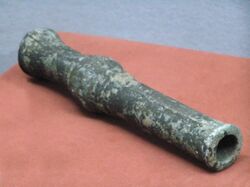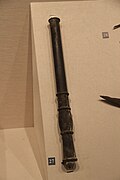Huochong
Topic: Engineering
 From HandWiki - Reading time: 3 min
From HandWiki - Reading time: 3 min

Huochong (simplified Chinese: 火铳; traditional Chinese: 火銃) was the Chinese name for hand cannons.[1] The oldest confirmed metal huochong, also the first cannon, is a bronze hand cannon bearing an inscription dating it to 1298 (see Xanadu gun).[2]
By the time of the Ming Dynasty (1368–1644) two types of huochong were in use. One was a hand held version with a wooden shaft known as a shouchong (手銃) whilst the larger Wankouchong (碗口銃 — bowl-mouthed cannon) or Zhankouchong (盏口銃 — cup-mouthed cannon)[3] rested on a supporting wooden frame. It was invented presumably as an advance in warfare, a new way to fight.
The Wankou Chong, translated literally as bowl-muzzle gun (Chinese: 碗口銃) was a type of Huochong gun used in the late Yuan and early Ming dynasties.[4][5] The cannons normally contained black powder, a wooden block or frame to contain the powder, and a large cannonball or a group of smaller cannonballs. The cannon was most commonly used to protect Chinese ports and to defend against pirates.[6][7] The cannon faded out of use gradually due to its short barrel, slow rate of fire, and short range.
Gallery
Bronze cannon with inscription dated the 3rd year of the Zhiyuan era (1332) of the Yuan Dynasty (1271–1368); it was discovered at the Yunju Temple of Fangshan District, Beijing in 1935. It is similar to Xanadu gun.
See also
- Hu dun pao, the term refers to trebuchet and cannon.
- Heilongjiang hand cannon, hand cannon, ca. 1287–1288.
- Xanadu gun, a bowl-mouthed hand cannon, 1298.
- Wuwei Bronze Cannon, late Western Xia (1214–1227).
- Gunpowder weapons in the Song dynasty
- Military of the Yuan dynasty
- Bedil tombak, Nusantaran hand cannon.
References
- ↑ "Chinese Military Technology and Dai Viet: c. 1390-1497". September 2003. http://www.ari.nus.edu.sg/docs/wps/wps03_011.pdf.
- ↑ "The World's Earliest Cannon (世界上最早的火炮)" (in zh). http://www.erdsi.net/sjszzdhp.html.
- ↑ Aung-Thwin, Michael Arthur (2011). New Perspectives on the History and Historiography of Southeast Asia: Continuing Explorations. Routledge. pp. 83. ISBN 9781136819643.
- ↑ "Chinese-style Firearms in Dai Viet (Vietnam) The" (in en). https://studylib.net/doc/8680973/chinese-style-firearms-in-dai-viet--vietnam--the.
- ↑ Duan, Weicong. "Ming China As A Gunpowder Empire: Military Technology, Politics, And Fiscal Administration, 1350-1620". https://openscholarship.wustl.edu/cgi/viewcontent.cgi?article=2748&context=art_sci_etds.
- ↑ "中国航海火器丨古代重型金属管型火器始祖——碗口铳_生活_澎湃新闻-The Paper". https://m.thepaper.cn/rss_newsDetail_8665226?from=.
- ↑ "洪武碗口銃(洪二十六)-數位典藏與學習聯合目錄(3049405)". https://catalog.digitalarchives.tw/item/00/2e/87/bd.html.
 |
 KSF
KSF







